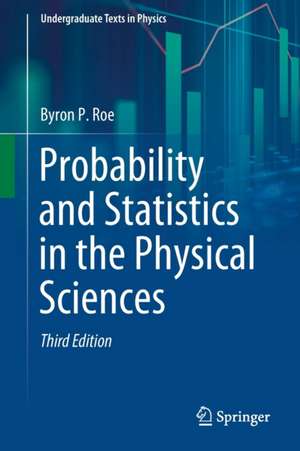Probability and Statistics in the Physical Sciences: Undergraduate Texts in Physics
Autor Byron P. Roeen Limba Engleză Paperback – 27 sep 2020
Preț: 489.65 lei
Nou
Puncte Express: 734
Preț estimativ în valută:
93.71€ • 97.47$ • 77.36£
93.71€ • 97.47$ • 77.36£
Carte tipărită la comandă
Livrare economică 12-26 aprilie
Preluare comenzi: 021 569.72.76
Specificații
ISBN-13: 9783030536930
ISBN-10: 3030536939
Pagini: 285
Ilustrații: XIII, 285 p. 54 illus., 5 illus. in color.
Dimensiuni: 155 x 235 mm
Greutate: 0.46 kg
Ediția:3rd ed. 2020
Editura: Springer International Publishing
Colecția Springer
Seria Undergraduate Texts in Physics
Locul publicării:Cham, Switzerland
ISBN-10: 3030536939
Pagini: 285
Ilustrații: XIII, 285 p. 54 illus., 5 illus. in color.
Dimensiuni: 155 x 235 mm
Greutate: 0.46 kg
Ediția:3rd ed. 2020
Editura: Springer International Publishing
Colecția Springer
Seria Undergraduate Texts in Physics
Locul publicării:Cham, Switzerland
Cuprins
Chapter 1. Basic Probability Concepts.- Chapter 2. Some Initial Definitions.- Chapter 3. Some Results Independent of Specific Distributions.- Chapter 4. Discrete Distributions and Combinatorials.- Chapter 5. Specific Discrete Distributions.- Chapter 6. The Normal (or Gaussian) Distribution and Other Continuous Distributions.- Chapter 7. Generating Functions and Characteristic Functions.- Chapter 8. The Monte Carlo Method: Computer Simulation of Experiments.- Chapter 9. Queueing Theory and Other Probability Questions.- Chapter 10. Two-Dimensional and Multidimensional Distributions.- Chapter 11. The Central Limit Theorem.- Chapter 12. Choosing Hypotheses and Estimating Parameters from Experimental Data.- Chapter 13. Methods of Least Squares (Regression Analysis).- Chapter 14. Inverse Probability; Confidence Limits.- Chapter 15. Curve Fitting.- Chapter 16. Fitting Data with Correlations and Constraints.- Chapter 17. Bartlett S Function; Estimating Likelihood Ratios Needed for an Experiment.- Chapter 18. Interpolating Functions and Unfolding Problems.- Chapter 19. Beyond Maximum Likelihood and Least Squares; Robust Methods.- Chapter 20. Characterization of Events.- Appendix.- Index.
Recenzii
“The depth and the manner in which the material is treated will make it easy for the students to transition to more advanced topics such as deep learning, machine learning and artificial intelligence after perusing the book. … Roe’s book is a wonderful, forward looking introduction to probability and statistics and its applications. Hence, I have no hesitations whatsoever in recommending the book – both to the students and instructors.” (Mogadalai P Gururajan, Contemporary Physics, August 19, 2021)
Notă biografică
Byron P. Roe is Professor Emeritus of Physics at the University of Michigan. He is a specialist in Experimental Nuclear and Subatomic Physics and Experimental Elementary Particle Physics. Professor Roe worked on an extensive number of experiments at Fermilab, CERN, and Argonne for more than 50 years and was often the spokesperson or co-spokesperson for these experiments. He has worked with the MiniBooNE neutrino experiment for almost 20 years. He is a Fellow of the American Physical Society.
Textul de pe ultima copertă
This book, now in its third edition, offers a practical guide to the use of probability and statistics in experimental physics that is of value for both advanced undergraduates and graduate students. Focusing on applications and theorems and techniques actually used in experimental research, it includes worked problems with solutions, as well as homework exercises to aid understanding. Suitable for readers with no prior knowledge of statistical techniques, the book comprehensively discusses the topic and features a number of interesting and amusing applications that are often neglected. Providing an introduction to neural net techniques that encompasses deep learning, adversarial neural networks, and boosted decision trees, this new edition includes updated chapters with, for example, additions relating to generating and characteristic functions, Bayes’ theorem, the Feldman-Cousins method, Lagrange multipliers for constraints, estimation of likelihood ratios, and unfolding problems.
Caracteristici
Features worked problems with solutions plus homework exercises Includes amusing, often-neglected applications Assumes no prior knowledge of statistical techniques Offers an introduction to neural net techniques Request lecturer material: sn.pub/lecturer-material










